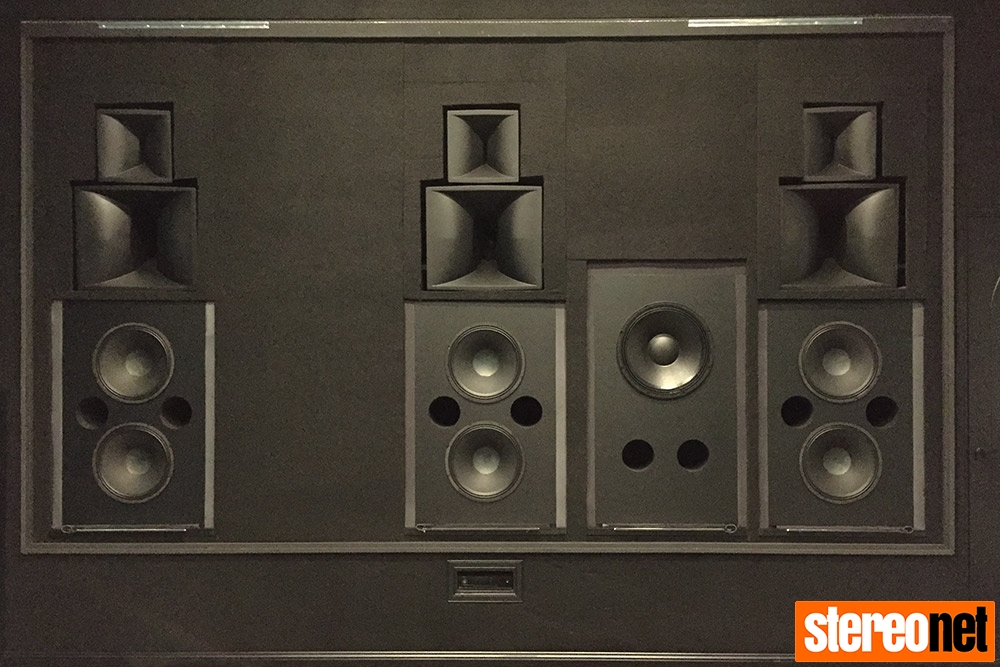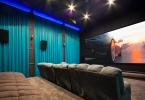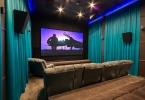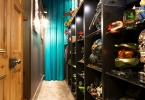The Church Of Sound Home Cinema

When it comes to do-it-yourself home cinema renovations, there’s few that can match the scale and wonder of this Krix Series X home cinema, converted from a 19th century church into a high tech movie and gaming paradise.
Built in 1896, the bluestone church north of Adelaide was used for over 110 years until the church and accompanying land were put up for sale. With future plans to convert the church into a home cinema, Matt and his wife Kate purchased the land and lived in the church for two years while their house was built on the adjoining block. Rolling forward to 2014 and with the family house completed, Matt then turned his attention towards his ultimate goal – a home cinema fit for the gods.
With experience gained from designing a custom home cinema previous, and with Kate handling the interior decorating, Matt already had a distinct idea of what he wanted to achieve. First and foremost he wanted to achieve it predominantly using his own labour and time. No mean feat for a home cinema the size of a church.
 The very start – a bare-bones view of the church interior.
The very start – a bare-bones view of the church interior.
 Minty, the family Dalmation checking in on progress.
Minty, the family Dalmation checking in on progress.
 Constuction beginning on the back wall with the projector housing.
Constuction beginning on the back wall with the projector housing.
So what did Matt set out to achieve for the ultimate home cinema room? Being a huge movie buff, Matt wanted an enormous picture and immersive cinema sound for a one-of-a-kind experience. This experience would also go a long way into realising the second, equally important criteria – to function as a gaming system for this Xbox family to play into the early hours of the morning.
Aside from the audio-visual requirements, the church needed to have areas to display Matt’s movie and game memorabilia, store countless UHD / blu-ray discs, as well as an area to store the processors, amplifiers and electronics that would drive the system. The room control needed to be hassle free and easy to use, from switching the air conditioning on, to adjusting lighting and ultimately controlling what was being played in the cinema. It also needed to be comfortable… warm, inviting and accessible.
 Front false wall construction with space for speakers and equipment racks behind the screen.
Front false wall construction with space for speakers and equipment racks behind the screen.
 The false wall was constructed using 90x45mm studwork, glued, screwed and covered with one layer of 16m MDF, two layers of 13mm plasterboard, then covered with acoustic material.
The false wall was constructed using 90x45mm studwork, glued, screwed and covered with one layer of 16m MDF, two layers of 13mm plasterboard, then covered with acoustic material.


The Krix Cinematix, a three way, dual 15” screen loudspeaker, would form the foundation of the sound system, but was surprisingly also the basis for many choices in the room.
According to Matt:
The cinema was fundamentally based around the Krix Cinematix speaker – everything from the depth and size of the data centre room, screen size and location, seat location, amplifier size, cable sizing, even the electrical load on the room. They really were the pivotal decision to bring the room together and man do they kick ass.
 Krix Series X Cinematic and Cyclonix unboxing for installation into the front baffle wall.
Krix Series X Cinematic and Cyclonix unboxing for installation into the front baffle wall.
 The finished baffle wall. The concept was introduced originally into commercial cinemas by Krix founder, Scott Krix in the early 1980s and it is still used by cinemas worldwide today.
The finished baffle wall. The concept was introduced originally into commercial cinemas by Krix founder, Scott Krix in the early 1980s and it is still used by cinemas worldwide today.



After experiencing the system in person… there’s no denying that fact. Sometimes, after hearing many speakers in smaller environments, it can be easy to forget just how much presence these beasts have in even the largest of rooms and auditoriums. Pairing the Cinematix with other Krix speakers including dual Cyclonix (front and rear) and ten Megaphonix surrounds, Matt was able to create a 7.2.4 immersive sound system capable of delivering crazy amounts of sound from every direction. There’s much to be said about having a larger dedicated space to deliver that true cinema sound.


During the build, Matt needed to ensure all cabling was run exactly where it needed to be. As many know, it’s a painstaking process to start cabling in a finished room, let alone a room of this size. To that end, no less than 100 metres of cable tray and 3 kilometres of cabling were installed to service power, speaker, subwoofer, lighting, fibre optic and lighting requirements.

Sensing just how much work the cabling alone took, we asked Matt what the biggest challenges were when undertaking the build. Unsurprisingly, height was the main answer. With a 4.5 metre ceiling, progress at times was slow and frustrating. Time also played a large factor. Balancing work, family life and the church build meant that progress could sometimes be slow.
Due to the length of the build, Matt was also concerned that some of the components his cinema was built around might be superseded or updated by the time the cinema was finished. Conversely, he was relying on affordable projector technology that didn’t exist at the time.
I needed a 4K projector that had at least 5000 calibrated lumens of light output for an affordable price. At the time I designed the cinema this was not possible, so I had to take a leap of faith and hope that technology caught up with my design. Fortunately, it did – I ended up going for an Epson large venue projector that for its price is awesome. Calibrated 4K picture and brightness is stunning, blacks are good and price unbelievable. However I would still like a native 4K, HDR, laser light source projector at some stage in the future.

You may be wondering what the neighbours think about the sound coming from the ‘church next door’. Fortunately for them, the walls are made of half-metre thick stone with 12mm glass in all windows. Every wall, ceiling and floor cavity is stuffed full of sound deadening material and insulation. So, while it looks like a church from the outside, passers-by are unaware of the formidable setup within.
As you might imagine, the complete setup has the potential to consume a lot of electricity. Wanting to offset the environmental impact, and sensing the pain of the forthcoming electricity bill, Matt had an 8kW solar system and battery hybrid system installed.
The cinema draws 500W of power in standby mode and about 1.5kW when running. When the volume is turned up and the amps start sucking juice, this number goes up even higher.
Lucky then, that Matt has around 5kW RMS of amplifier power at his disposal for when things really heat up!
 The foyer leading into the cinema houses all the source material, extra memorabilia and of course a vintage popcorn machine.
The foyer leading into the cinema houses all the source material, extra memorabilia and of course a vintage popcorn machine.
All up, the build took 3 years to complete. As he had hoped, Matt was able to complete almost all of the work by himself and in his own time. After looking through the foyer, cinema room and behind the screen, we were amazed at the level of care and detail. Not only in the technical aspects of the installation, but also in the care taken in staying true to the original style of the church. Cathedral arch doors, architraves, styled wall sconces and corbel trim add charm and pay homage to the history of the building.

While we were there, we were lucky enough to be given a range of movie and Xbox demonstrations, starting with the first scene from Fate of the Furious and ending with the ever-entertaining sovereign fleet chase scene from Guardians of the Galaxy 2.
Matt’s plan had come to fruition. Every design choice and piece of equipment combined to provide a visceral experience that rivaled and even outperformed that of some of the best cinemas we have been to. When asked the best part about the build, Matt’s answer was simple; “Seeing my vision come to reality”. With years of time and effort culminating in a cinema experience of that level, we can wholeheartedly see why.
Room specs and equipment list
- Cinema room size is 6.1m wide, 10m long with 4.5m ceilings
- Epson EB-G7400UNL large venue 4K Enhancement projector fed by a Celerity Fibre Optic HDMI Cable
- OzTheatre Majestic 190” 16:9 Custom 4K Acoustically Transparent screen
- Cinema control is via an iPad running iRule/Global Cache for the hardware control and Clipsal C-Bus for lighting and cooling control
Speaker configuration is 7.2.4 with dual arrayed side surrounds (total 15 speakers)
- Front Left/Right Speakers: Krix Cinematix x2
- Centre Speaker: Krix Cinematix
- Side Surround Speakers row 1: Krix Megaphonix x2
- Side Surround Speakers row 2: Krix Megaphonix x2
- Rear Surround Speakers: Krix Megaphonix x2
- ATMOS Ceiling Speakers: Krix Megaphonix x4
- Subwoofer Front: Krix Cyclonix
- Subwoofer Rear: Krix Cyclonix
Rack 1
- 17″ Monitor
- Xbox One X Console
- Fetch Mighty Set Top Box
- Xbox 360 Console
- Panasonic DMP-BD900GNK 4K UHD Blu-Ray Player
- Belkin PF-40 Power Conditioner
- Calibration Laptop
- Behringer Ultradrive PRO DCX2496
- Marantz AV8802a Processor
- Water Cooling Panel
- Home Server PC
- APC UPS
Rack 2
- TP-Link GigaBit Switch
- Power Conditioner Belkin PF-30
- Emotiva XPA-2 Gen 2 Amplifier (Centre)
- Emotiva XPA-5 Amplifier (Surround L1, L2, Rear-Left, Atmos Front Left, Atmos Rear Left)
- Emotiva XPA-5 Amplifier (Surround R1, R2, Rear-Right, Atmos Front Right, Atmos Rear Right)
- Projector UPS
Rack 3
- Power Conditioner Belkin PF-30
- Emotiva XPA-2 Gen 2 Amplifier (Front Left)
- Emotiva XPA-2 Gen 2 Amplifier (Front Right)
- Emotiva XPA-1 Gen 2 Amplifier (Front Subwoofer)
- Emotiva XPA-1 Gen 2 Amplifier (Rear Subwoofer)
The article The Church of Sound was first published by Krix and reproduced with permission.
Marc Rushton
StereoNET’s Founder and Publisher was born in England and raised on British Hi-Fi before moving to Australia. He developed an early love of music and playing bass guitar before discovering the studio and the other side of the mixing desk. After a few years writing for audio magazines, Marc saw the future in digital publishing and founded the first version of StereoNET, known at the time as Planet Audio, in 1999.
Posted in:Home Theatre
Tags: krix
JOIN IN THE DISCUSSION
Want to share your opinion or get advice from other enthusiasts? Then head into the Message Forums where thousands of other enthusiasts are communicating on a daily basis.
CLICK HERE FOR FREE MEMBERSHIP
Trending
applause awards
Each time StereoNET reviews a product, it is considered for an Applause Award. Winning one marks it out as a design of great quality and distinction – a special product in its class, on the grounds of either performance, value for money, or usually both.
Applause Awards are personally issued by StereoNET’s global Editor-in-Chief, David Price – who has over three decades of experience reviewing hi-fi products at the highest level – after consulting with our senior editorial team. They are not automatically given with all reviews, nor can manufacturers purchase them.
The StereoNET editorial team includes some of the world’s most experienced and respected hi-fi journalists with a vast wealth of knowledge. Some have edited popular English language hi-fi magazines, and others have been senior contributors to famous audio journals stretching back to the late 1970s. And we also employ professional IT and home theatre specialists who work at the cutting edge of today’s technology.
We believe that no other online hi-fi and home cinema resource offers such expert knowledge, so when StereoNET gives an Applause Award, it is a trustworthy hallmark of quality. Receiving such an award is the prerequisite to becoming eligible for our annual Product of the Year awards, awarded only to the finest designs in their respective categories. Buyers of hi-fi, home cinema, and headphones can be sure that a StereoNET Applause Award winner is worthy of your most serious attention.
























